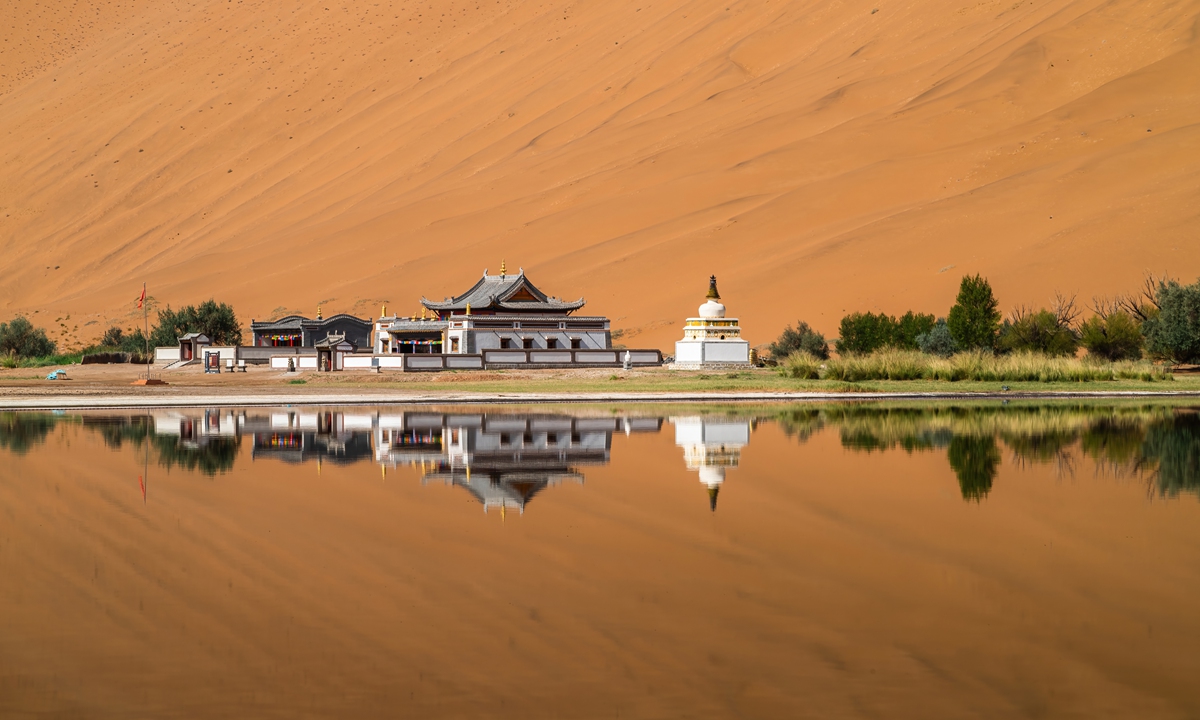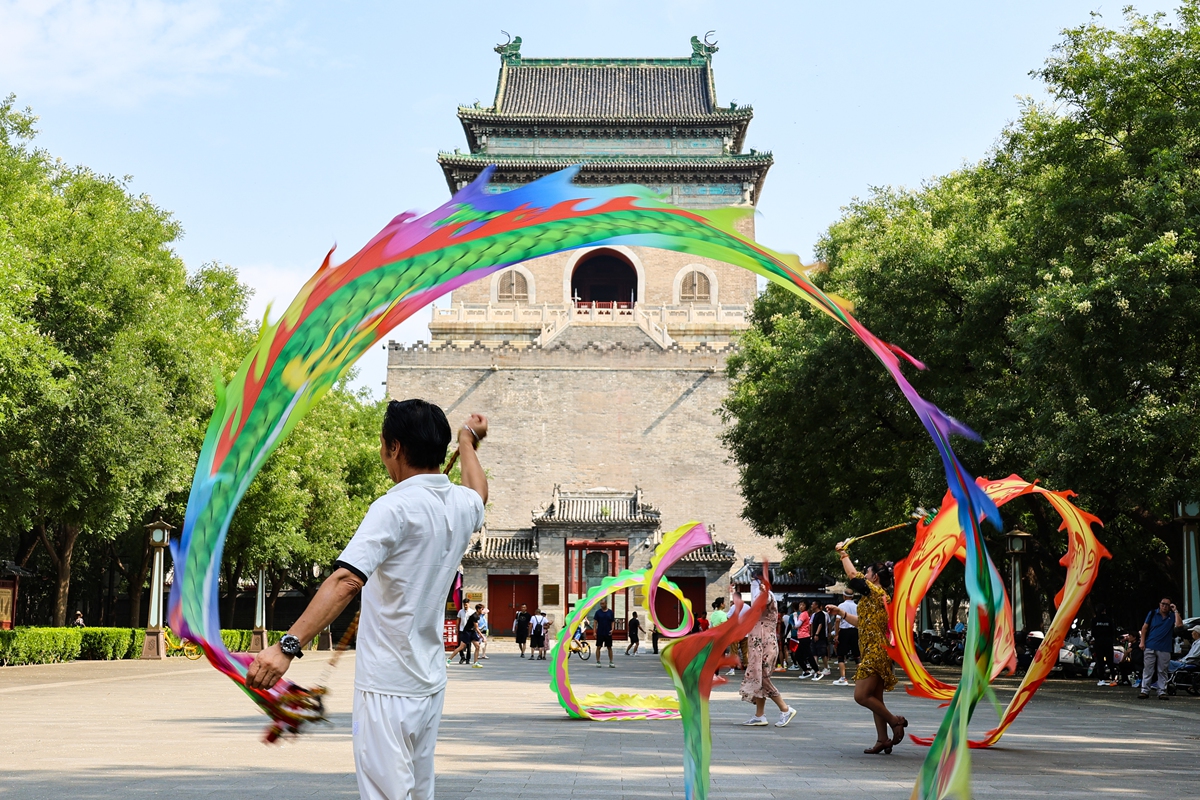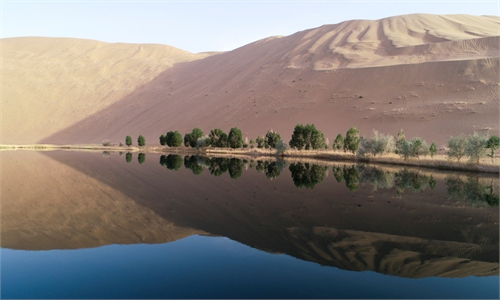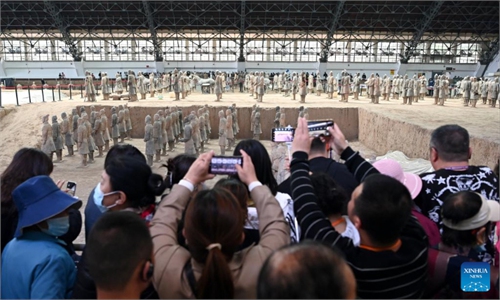ARTS / CULTURE & LEISURE
The glamour of China’s cultural and natural legacy in the new era
Treasure of humanity

Badain Jaran Temple in the Badain Jaran Desert, North China's Inner Mongolia Autonomous Region. Photo: VCG
Editor's Note:
Chinese President Xi Jinping highly values efforts to preserve cultural and natural treasures and renew their glamour in the new era.
Xi, also general secretary of the Communist Party of China Central Committee and chairman of the Central Military Commission, has called for further efforts in an instruction on strengthening the protection, preservation and utilization of cultural and natural heritage.
The instruction was made after one cultural heritage and two natural heritages of China were inscribed on the World Heritage List by the United Nations Educational, Scientific and Cultural Organization (UNESCO) in July 2024.
Xi also called for enhanced international exchange and cooperation in this field, and efforts to make greater contributions to the Global Civilization Initiative (GCI) and the building of a community with a shared future for humanity.
August 15 marks China's second National Ecology Day. The three new heritages reveal the concept of harmonious coexistence between human and nature, and contribute to the world's biological diversity.
In this issue, the Global Times Life Desk maps out the lively examples of Chinese modernization and harmony between humanity and nature, and China's active engagement in international dialogue and cooperation in world heritage protection under the guidance of the GCI.

An inland lake (commonly known as Haizi) in the Badain Jaran Desert, North China's Inner Mongolia Autonomous Region. Photo: VCG
Every year, when winter arrives, growing numbers of birds, including some species in danger such as red-crown cranes, can be seen landing around the wetlands on the fringe of China's Badain Jaran Desert and also around Chongming Island of Shanghai, both inscribed onto UNESCO's World Heritage List in July, to survive the cold. As for Beijing swifts, another kind of migrant bird, April in the capital is a golden time to nest and breed, and the roofs of ancient buildings along the Central Axis of Beijing will once again become their dream home.
All of these world heritage sites play a pivotal role in providing a home for a variety of birds, which have been increasing in number alongside China's efforts in conservation and development of heritage sites. The story of these migrant birds is just a tiny part of what is happening at world heritage sites around China.
Whether they are natural heritage sites like the Badain Jaran Desert or cultural sites like the Central Axis of Beijing, each heritage site in China has its own unique and irreplaceable role to play, not only in regard to the evolution of human civilization but also as a stabilizer for the Earth's natural environment, experts noted.
In July, UNESCO announced the inscription of the Beijing Central Axis: A Building Ensemble Exhibiting the Ideal Order of the Chinese Capital, the Badain Jaran Desert - Towers of Sand and Lakes, and the Migratory Bird Sanctuaries along the Coast of Yellow Sea-Bohai Gulf of China (Phase II) on its World Heritage List at the 46th session of the UNESCO World Heritage Committee held in New Delhi, India.
The ancient axis helped to build an ideal urban landscape, while lakes in the desert and the sanctuaries for migratory birds on the coastline are an integral part of the harmonious relationship between humanity and nature.
"We can see diverse special ecosystems at every natural world heritage site in China, and each of them has a significant role in stabilizing the general circulation of the atmosphere and ensuring the safety of biodiversity," Zhang Yujun, a professor and director of the National Park Research Center of Beijing Forestry University, told the Global Times.
When speaking of the reasons why the Central Axis of Beijing should be included in the World Heritage List, Lü Zhou, director of the National Heritage Center at Tsinghua University, told the Global Times that the ancient axis fills a gap in the World Heritage List in terms of the ideals surrounding Eastern capital city planning and the types of core architectural complexes it possesses.
Zhang Peng, head of the Memorial Hall of Guo Shoujing and a veteran cultural expert, told the Global Times that besides marvelous architecture, the centuries-old lush trees and water landscapes along the axis that are often seen as natural scenic spots have been "dyed" in cultural attributes, making them irreplaceable parts of the heritage site.

Birds take to the air at the Yellow River estuary wetland in Dongying, East China's Shandong Province. Photo: VCG
'Breathing' heritage
In his instruction, Xi called for efforts to take this UNESCO inclusion as an opportunity to further strengthen the comprehensive and systematic protection of cultural and natural heritage sites and make good use of them to better meet the people's needs.
Making heritages a "breathing" part of modern life rather than static historical displays is China's goal when utilizing both its natural and cultural heritage resources. The sustainable utilization of heritage sites is "multi-dimensional" and includes sectors like "smart digital delivery, public's participation and IP transformation," cultural policy expert Song Weiping told the Global Times.
The Central Axis of Beijing is using digital means to monitor the site's "health condition." The program was started in 2021, when a center dedicated to the digital conservation of the heritage site was launched.
Relying on China's domestically produced Beidou Navigation Satellite System, the center's equipment is able to monitor sites along the Central Axis of Beijing to a micrometer-level.
The center's other facilities like the "Digital Twin" real-time map and "Mobile Patrolling" app have made heritage management much more "efficient," Zhou Ziyu, the director of the center's monitoring department, told the Global Times, adding that digital technology is a "necessary assistant" that helps experts see "unseen" problems.
Smart "assistants" are also involved in conservation efforts at another of China's World Heritage Sites - the Great Wall.
At both the Jiankou and Badaling sections of the Great Wall, unmanned aerial vehicles (UAV) are used not only for monitoring, but also capturing fuller images of sites to make a three-dimensional model of the Great Wall.
Shang Jinyu, an expert who is responsible for the digital project at Jiankou Great Wall, told the Global Times that digital devices have helped them to see "some neglected and extremely fragile parts that need to be repaired."
Although these technical devices are smart, they can never replace the importance of people in heritage conservation. For example, generations of villagers have worked to safeguard the Badaling Great Wall, "a heritage that can only 'live' through interacting with the public," Li Dan, a representative from the Administration Office of the Badaling Great Wall, told the Global Times.
Due to its remote location, the natural World Heritage Site Badain Jaran Desert - Towers of Sand and Lakes in North China's Inner Mongolia Autonomous Region "has long been relying on local villagers' voluntary patrolling thanks to their love of their home," Liang Baorong, the director of the Alxa Right Banner Administration Bureau of the Alxa Desert UNESCO Global Geopark, told the Global Times.
"Not only villagers, the site has also intrigued university research groups, foreign experts and in future, we will aim to develop it into an iconic tourist site," Liang told the Global Times.
Through "cultural tourism," China's heritage resources are sustainably used and better engage the public. Relying on China's archaeological sensation, the Sanxingdui Ruins, the new Sanxingdui Museum has become a popular hot spot that attracts more than 4.8 million people a year.
The site has launched experiential programs like "on-site archaeological games" and has also co-launched exchange forums with the Liangzhu Ruins in Hangzhou. Its iconic relics like the "Gold Mask" and "Bronze Figurine" have been turned into blind box toys, stationary and even ice cream products that have proven popular among young visitors.
Song told the Global Times that heritage sites like the Sanxingdui Ruins and Liangzhu Ruins are seeking to broaden their "archaeological IPs" to boost "urban tourism, local cities' cultural identity as well as international exchanges."

Citizens dance with dragon-shaped colored ribbons at the cultural square of the Bell and Drum Towers to celebrate the inclusion of the Beijing Central Axis in the World Heritage List in Beijing in late July. Photo: VCG
A testament to the GCI
China's rich tapestry of cultural and natural heritage is now adorned with 59 World Heritage Sites, a witness to the nation's profound history and ongoing commitment to global cultural diversity. Among these, "The Silk Roads: the Routes Network of Chang'an-Tianshan Corridor," a joint venture with Kazakhstan and Kyrgyzstan, stands as a beacon of international cooperation in preserving cultural heritage sites.
Lü told the Global Times that China's adherence to the World Heritage Convention has been a testament to the country's open and collaborative spirit. China stands as one of the world's most endowed nations in terms of cultural and natural treasures.
China's active engagement with UNESCO and other contracting states has fostered a conducive environment for international dialogue and cooperation. The inclusion of the Central Axis of Beijing underscores China's dedication to the Global Civilization Initiative, emphasizing its respect for cultural diversity and the significance of cultural heritage in fostering mutual understanding and respect among civilizations.
Wang Yiwei, vice president of Academy of Xi Jinping Thought on Socialism with Chinese Characteristics for a New Era, told the Global Times that the GCI underscores the idea that ancient civilizations can achieve modernization and contribute to contemporary human civilization. The initiative promotes the view that civilization is not a monolithic concept but a diverse and inclusive reality that encompasses various cultural expressions.
Currently, China and Egypt are embarking on a collaborative journey to nominate the Baiheliang Ancient Hydrological Inscription, the earliest low water hydrological inscriptions to be found in Southwest China's Chongqing Municipality and the Nilometers, an ancient instrument used to measure the waters of the Nile river in Egypt as new World Heritage Sites. This joint endeavor has seen teams from both countries engaging in mutual visits and efforts to forge a path for a joint application.
Xie Maosong, a senior research fellow at the China Institute for Innovation and Development Strategy and the director of the Research Center of Chinese Civilization and Chinese Path, told the Global Times that such collaboration exemplifies China's active commitment to the GCI.
Launched at the 44th World Heritage Convention in Fuzhou, Fujian Province, the Fuzhou Declaration highlighted the need for increased support for developing countries, particularly those in Africa and small island nations. This declaration is a clear indication of China's willingness to share its experience and expertise in heritage conservation, which is especially beneficial for countries in the Global South.
"Both Baiheliang and the Nilometers are hydrographic relics and related to two of the greatest rivers in the world," said Xie, adding that they reflect how different agricultural civilizations in Asia and Africa relate to their respective river resources.



